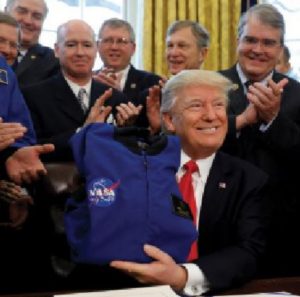 As the world celebrated the 50th anniversary of the Apollo 11 moon landing, which was the first time the humankind had set foot on the moon, US President Donald Trump set a hasty target of 2024 for NASA to return Americans to the moon. Trump has strangely shown keen interest in the nation’s space programme, asking the NASA to speed up its programmes to the moon, and eventually to Mars. The last manned mission to the moon was in 1972 when the Apollo 17 mission landed on the moon. Since then, there has been a 50-year lull, with no manned mission.
As the world celebrated the 50th anniversary of the Apollo 11 moon landing, which was the first time the humankind had set foot on the moon, US President Donald Trump set a hasty target of 2024 for NASA to return Americans to the moon. Trump has strangely shown keen interest in the nation’s space programme, asking the NASA to speed up its programmes to the moon, and eventually to Mars. The last manned mission to the moon was in 1972 when the Apollo 17 mission landed on the moon. Since then, there has been a 50-year lull, with no manned mission.
Amid the intense cold war rivalry in the 60s, US allocated a colossal budget to NASA to go for the Apollo programme and land the astronauts in the moon. Back then, the country had both the political will and the huge budget to embark on the humanity’s most daring milestone. The manned space launches take enormous amounts of money, which very few countries can afford. The enthusiasm faded after the 70s as the US had achieved supremacy over the Soviet Union in space domain, and with dwindling finances, NASA could hardly manage such challenging missions. NASA’s space shuttle programme was also discontinued by 2011 due to the lack of resources to run the exceptional engineering marvel.
However, there is a renewed interest amongst the fledgling private corporations, and NASA itself, to again go for manned lunar missions. The effort this time is led by private companies that are also seeing a business potential in designing such launch programmes. Buoyed by Trump’s announcement that he was going to rejuvenate the nation’s premier space agency, NASA is on track to built a Gateway around the moon, which could serve as a launchpad for deeper space missions.
The Gateway, under the Artemis programme, will serve as a temporary home for the astronauts while it orbits the moon. Just like a space station, the Gateway will house laboratories for science and research, docking ports, serving as a home base for expeditions to the moon and mars. NASA is partnering with US companies and the international space agencies to build the Gateway within the next decade. The aim is to build a sustainable presence on the moon.
The space agency’s much touted Space Launch System (SLS) and the Orion spacecraft will play an incremental role in the realisation of this critical mission. The ambitious Space Launch System is being built along with Boeing and a number of other private companies. Both the SLS and the Orion capsule can be subject to modifications and altered in design from time to time to allow new technologies and systems as they develop. The systems are compatible with deep space missions, other than just the moon landing.
So how does NASA plan to meet such a narrow deadline of 2024 for moon landing? The premier space agency has roped at least 11 private companies who are partnering with it to develop the different stages and technologies for the monumental mission. The last decade has seem the boom of private space companies who have been tremendously successful in designing and launching their own missions. The companies like the SpaceX, Blue Origin, Florida-based Moon Express, Astrobotic, including a number of others, have already set their eyes on the moon and beyond.
While these companies are partnering NASA in its efforts, they have been working on their own missions and been very successful at them. NASA has in recent years aggressively outsourced a lot of work to these agencies and that seems to be its long-term plan. The moon landing, according to NASA will be a combined effort of private companies and international space agencies. NASA won’t be alone.
Blue Origin, a private space company, floated by the billionaire Jeff Bezos, announced it had developed its own ‘Blue Moon’ lander, which has the ability to land a 4,500 kg payload on the lunar surface. The company believes it will be ready to fly its first moon mission in the next few years. Jeff Bezos has ambitious plans which include setting up a permanent human colony on the moon and help advance human exploration beyond our natural satellite. The company is aiming to tap the satellite launch business as well as pave the way for space tourism. Another company, Virgin Galactic, has already tested its SpaceshipTwo spacecraft in the low-earth orbit, in which it plans to send space tourists to as high as 50 miles.
The Japanese private organisation iSpace is developing a series of landers and rovers to explore on the lunar surface. The company already has plans to send its spacecraft aboard the Falcon 9 rocket of SpaceX by 2021. Another American company, known as Intuitive Machines, has been selected by NASA to send its payloads to the Moon, also using SpaceX Falcon 9 rocket in 2021.
Coming to the most successful private space company, SpaceX, which has been tremendously successful with its rocket launches. The Elon Musk-led SpaceX is already dominating the market with NASA using its launch services to send crewed mission to the International Space Station (ISS). SpaceX was the first space agency to develop reusable launch vehicles with its phenomenal Falcon rockets. The company’s ultra cheap and reusable launch vehicles gave it a dominant position in the market, which NASA itself using much of its services, along with Boeing, in its space missions.
The company’s flamboyant CEO Elon Musk revealed his insanely ambitious design of the the mega spacecraft, called the Starship, which will serve as an interplanetary transport vehicle for humans. Starship is currently under development and Musk aims to test it within as soon as six months time. The Starship is expected to ferry passengers to the moon and Mars, then back to earth, repeating the same journeys over time. Since launching its first satellite successfully 11 years ago, SpaceX has come a long way and set new benchmarks in the space industry sector.
Spacex, along with Boeing, are working to develop the Commercial Crew for NASA, which it wants to use for transporting astronauts to ISS and back, but both companies have been missing deadlines on that. Boeing is helping NASA develop the next-generation Space Launch System, aimed for moon in the near future.
NASA administrator Jim Bridenstine speaking at the recently held International Astronautical Congress said the US has plans to land humans on Mars in the 2030s. He indicated the moon landing was closely related to the mars landing and the progress in the former will automatically help meet the deadline for the the latter. NASA also recently indicated its partnership with Japan Aerospace
Exploration Agency (JAXA) for its crewed lunar missions. Besides, the European Space Agency is reportedly a partner in the Gateway project, which will also see the collaboration of many more space-faring nations. To be clear, every major space mission will involve the effort of a conglomerate of organisations and governments working together to pool the funding and resources, which can accelerate the exploration endeavours.
NASA has realised if it wants to return humans to the moon and accelerate the outer space exploration, which has seen a stagnant phase in the last decades, it will have to join hands with private corporations and foreign governments. The agency is outsourcing most of its functions and hopes to only oversee the mission developments, while providing funding and expertise to smaller companies. The last decade has shown that the future of human exploration lies in privatisation, while the governments find such missions cumbersome and unaffordable. The interest for the moon and beyond is reviving, while the space tourism is almost here. We have to realise that it’s only through global collaborations that such monumental undertakings can see the light of the day. The expertise and resources of individuals and organisations worldwide when pooled together can help the humanity achieve the impossible.
letters@tehelka.com













